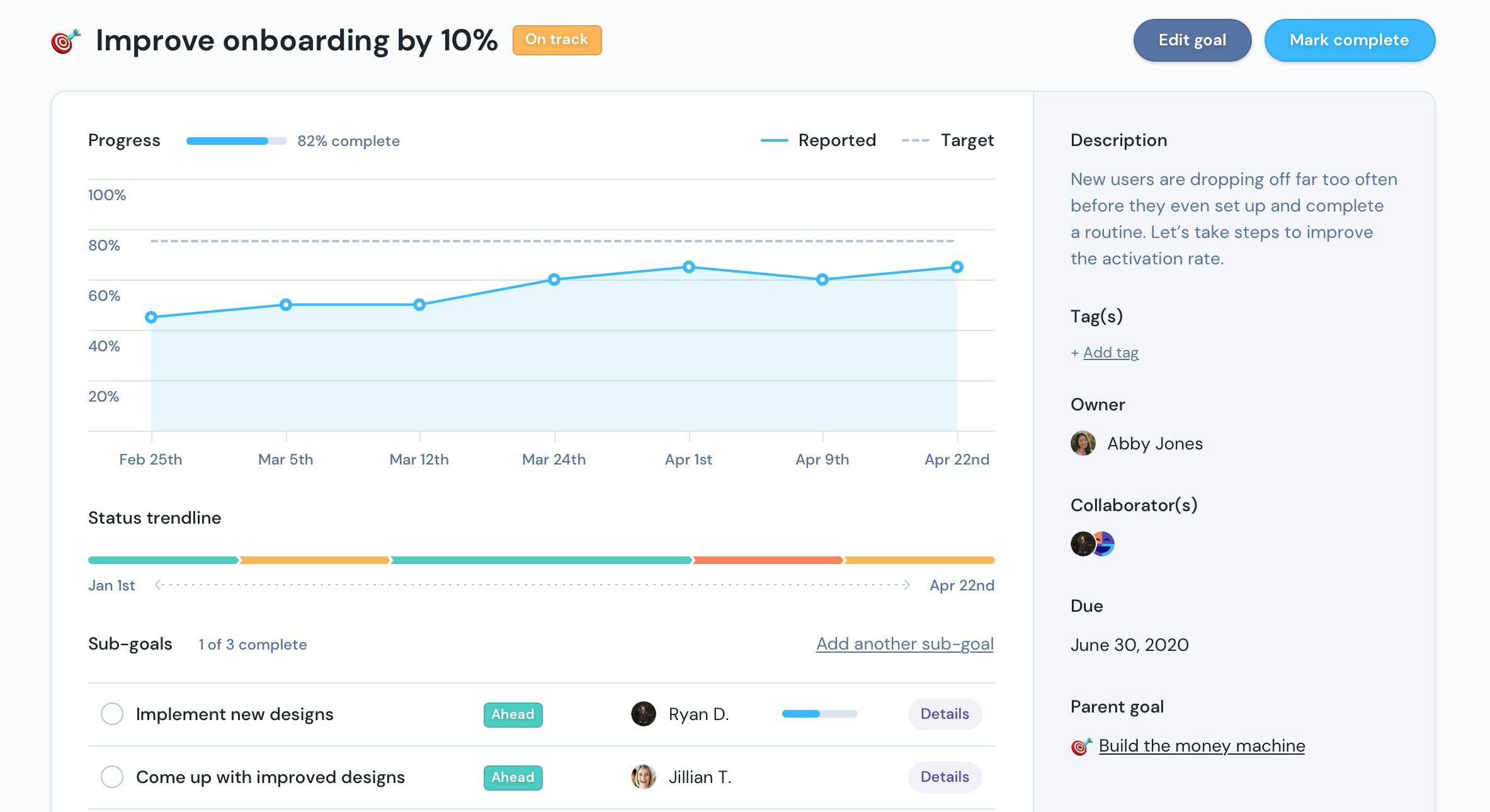The Secret To Setting Top Team Goals

It really is simple. When we work together, we’re more likely to achieve our goals. It’s a fact that’s existed since the conception of humanity, so it’s not going away anytime soon.
Accepting that teamwork is everywhere only goes so far. In order to maximize the potential of the group, you need to know how it ticks. The beating heart of any collaboration is the team goal, the common pursuit among all that pushes everyone along.
Set effective team goals and your team is not only more willing to work together, but also stay motivated throughout the project. Invite team members into the creation of those goals and things really start to get interesting.
Why Team Goals?
Far from being anything too complicated, team goals are simply the aims and objectives of a team. Though, this commitment to collaborate well and succeed accordingly can take a few forms.
Quantitative goals are all around us – increase yearly sales by 15%; reduce product defects by 25%; raise employee retention rate to 80% – but exclusively setting these goals can prove counterproductive. People should be given the chance to accomplish goals that are both valuable for their company and relevant to them.
Developing skills, increasing team morale and finding improved methods of working together are qualitative goals, difficult to measure precisely but insanely important, nonetheless. Inviting team members to generate ideas, especially if they’ve not done so before, is one example of an effective team goal.
Team goals, then, are an opportunity to align individuals towards a shared pursuit. Whether it’s a goal that is measured or felt, the underlying principle is to allow team members to take an active role in goal setting, developing themselves and investing further into their company.
Top Team Goals
Whereas individual goals are often extremely personal, team goals should be framed in a way that allows many team members to associate with them. At the same time, overly generalizing team goals – “be more productive” – won’t allow participants to determine exactly what they’re working towards.
With that in mind, here are some top team goals to get going at your workplace.
1. Define Business Strategy
Simply by virtue of frequency, day-to-day tasks often take precedent over larger corporate visions. In fact, the research of Chris Zook, partner at management consultant Bain & Company, suggests that a mere 40% of employees organization-wide are aware of company goals.
It is no coincidence then that just 13% of employees worldwide consider themselves engaged in their work, as told by one Gallup poll. In the US and Canada, that number rose to 29%, still leaving over two-thirds of the workforce lacking motivation.
As team goals should always be subordinate to business strategy, it is a huge problem if employees cannot relate their work to the larger aims of their company. A common determiner of motivation is the ability of a worker to see beforehand how their work will contribute to the greater success of the business.
As business strategy is a precondition for goals (i.e., you can’t hit unestablished targets), having a team collaborate on it can dramatically increase goal-commitment. If you are convinced that every member understands their role fully, it is still valuable to periodically reassess how individual action contributes to larger company aims.
2. Performance Goals
The primary goal is the actual purpose of the team, why it has been created and to what end it functions. Naturally, this takes center stage. Performance goals are the stepping stones that allow a team to fulfill their primary objectives. These are most commonly quantitative, dealing with financial outcomes, operational metrics and customer dynamics.
Examples include:
- Increase website traffic by 5% each month for six months
- Maintain customer retention rate of 85% throughout the year
- Raise customer service feedback by x points by October
- Get average handle time (AHT) to 4 minutes by next month
- Use lead score data to increase conversion by x %
- Reduce open tickets by 10% every month until threshold met
- Raise average review score from 3.9 to 4.5 by June
- Lower weekly overtime from 3 to 1.5 hours
- Increase sales in region x by 10% by the end of the year
These goals are fairly self-explanatory to team leaders, as they rely on standardized metrics.
However, to individual team members, they may sound like white noise, constantly heard yet meaningless.
Turning goals into action plans becomes vastly easier when all employees have been included in the creation process. Not only do they associate more strongly with the work, but they better understand the results of their actions.
Team goal setting allows all participants to clarify the value and impact of their performance, converging many perspectives into a unified idea of what is expected of them. This is essential for role responsibility as well as long-term motivation.
3. Strengthen Team Relationships
Ah yes, the dreaded team-building exercise. The poor reputation of these activities is often a result of a misguided approach, albeit mixed with genuinely good intentions. The crucial element is understanding the root purpose of team building.
As team-building exercises are supposed to be educational, let’s take a look at some relevant theories. Content and Language Integrated Learning (CLIL) is one method of teaching foreign languages, in which the target language is taught through subject context. For example, students may be taught biology in Chinese, or math in Spanish.
In much the same way, team-building exercises are concerned with the underlying team “language,” not just the actual game. These exercises should work the skills required for effective teamwork, namely communication, decision-making and collaboration.
Here are some productive examples:
- The Barter Puzzle: Using a few 50-piece puzzle sets, divide the group into smaller teams. Each team is tasked with completing their puzzle. However, the puzzles have been mixed, meaning that teams must negotiate with one another to trade other pieces for their own. The team who finishes first wins. Target skills: collaboration, negotiation, problem-solving
- Company Emblem: As a group, create a list of words and phrases that the company embodies. Then, in smaller teams, have them design and create emblems based on 4-5 chosen terms. Teams can then pitch their logos as the design that best represents company values. Target skills: idea-generation, collaboration, presentation
- Blind Draw: Divide the group into smaller teams. Each round, one member of each team is the artist, who must draw an object on their team board. However, the artist is never told what they’re drawing. The rest of the teams are shown the target object and must verbally instruct, without saying the object’s name. Artists cannot see other team boards. After a time limit, the most accurate drawing wins a point. Target skills: communication, collaboration, leadership
Even though they seem jovial, the underlying principle of team-building exercises is to enhance collaboration by finding the most effective ways of achieving a task. In this regard, icebreakers and team bonding activities play a different role and can be thought of as separate.
4. Concurrent Development
In the second chapter of The Jungle Book, Rudyard Kipling writes that “the strength of the pack is the wolf, and the strength of the wolf is the pack.”
While the link to the dog-eat-dog world of business is obvious, these words are as much to do with unity.
Personal development goals should be encouraged in any organization, as means to further employees and diversify skills. Within a team, however, shared personal goals are exceptionally powerful.
A 2020 study saw that those who shared their goals with others whose opinion they valued, typically people of higher status, were more committed to achieving them. At the same time, team members can support each other with their concurrent personal goals, similar to how friends sharing a New Year’s goal motivate one another to continue.
If you’re after some good examples, here are a few:
- Read Relevant Material to Your Industry: Reading a text related to your industry, company or business is a worthwhile pursuit, leading to better insight and more informed opinions. When multiple team members share this task, however, they are able to experience this growth together. They can discuss their interpretations of the material and share ideas.
- Learning Opportunities: A majority of organizations offer workshops to some extent, though sometimes if employees must attend involuntarily their effectiveness dwindles. Encouraging team members to approach opportunities for growth – talks, courses, and clubs – together can be more productive in the long run. Facilitating such activities in-house can add tremendous value to a team.
- Adopt New Formats: In the continual effort towards optimal productivity, it is immensely valuable to try new ways of working. If you’ve seen some promising software mentioned in an article or learned of a new productivity system, introducing it to your team is more often than not an appreciated contribution.
- Health Goals: Adopting healthier habits in other aspects of life can significantly boost work output. Accordingly, modern workplaces are moving towards holistic mind-sets. The 2018 Hero Health and Wellbeing Report showed that organizations that prioritize employee health and work/life balance have higher median satisfaction rates (85%), suggesting that these goals are just as influential as the strictly professional.
Setting concurrent personal goals, or any unified endeavor, strengthens the bonds of a group. While team members should definitely be reminded of how their actions contribute to larger business movements, the importance of accommodating personal growth as part of work life must be acknowledged.
5. Team Recognition Initiatives
If your team is consistently hitting the targets thrown at them, it’s natural to want to maintain that energy.
“One way to keep momentum going is to have constantly greater goals,” as English novelist Michael Korda proposed.
While this may be true, a team needs to be periodically rewarded for their hard work.
While “team” is often collated with “morale” and “spirit,” this problem goes way beyond project collaboration and to the organizational level.
“65% of people receive no recognition for good work in their workplaces,” according to older Gallup findings.
Establishing a team recognition initiative is an opportunity to acknowledge both individual contribution and collective effort, which in turn leads to further commitment. Research shows that this type of incentive has a huge effect on motivation, thus having the team responsible for their own reward system can drastically boost motivation.
The Science of Team Goals
In words attributed to legendary football coach Vince Lombardi – a man with five NFL championships and plenty of teamwork philosophy – “individual commitment to a group effort… is what makes a team work, a company work, a society work, a civilization work."
While your company is probably more interested in customer conversions rather than the touchdown kind, you’ll see an obsession with goals in both fields.
As a 2018 entry in American Psychologist reads, “Team goal-setting… reduces ambiguity by giving the team a shared understanding of the team’s objectives… [which] establishes a shared mental model.”
Ipso facto, the process of goal-setting improves a team’s ability to achieve said goals, a claim backed up by goal-setting theory. People responsible for the creation of their own team goals are more committed to colleagues and connected to the company. This means that members should be somewhat influential in the development of their objectives.
The greatest advantage of having a team is the fact that you can accomplish more difficult challenges than individuals, principally because team members combine their diverse and complementary skills. Setting goals as a team gives everyone the opportunity to display and develop their skills and contribute their unique experiences.
How to Set Team Goals: 7 Steps
The basic outline for setting team goals goes like this:
- Define company vision
- Set relevant team goals
- Generate an action plan
- Set individual professional goals
- Make tasks S.M.A.R.T.
- Track progress with goal tracking apps
- Recognize good work
For a more comprehensive overview, check out the goal-setting guide.
The first step in team goal setting is to establish the primary goal and the parameters for success. This will inform your action plan, the steps that must be taken to achieve a target.
Once the initial goal is known, start thinking about how each team member will contribute. Consider the strengths and weaknesses to assess how specific people can support others in reaching the goal.
As crucial as goals are, we all know that they’re not enough alone. It takes an action plan to translate intangible aims into measurable tasks. A detailed description of how exactly the goal is achieved, this centralized document is the keystone of a team project.
It should include a schedule, member roles and responsibilities, pertinent details and a method of tracking progress. You can make your life easier by utilizing goal-setting software, such as Friday.
How To Set Goals in Friday
Friday integrates goal-setting software directly into our simple-to-use planner and team communication tool. It’s like the homepage for your whole team at work.

With Goals in Friday, you can:
- See key success metrics you’re trying to achieve for more focused productivity
- Share progress and provide context to key stakeholders to spend less time in meetings
- Set team goals and priorities, while also setting individual professional goals
- Know how the whole organization is doing with all goals in one view
- Connect goals to your everyday work. Strategy in action!
You’ll also get:
- Team check-ins to know what’s going on
- Company handbook for your most important things at work
- Posts to add context to your Slack conversations
Start your team on Friday for free.
Final Thoughts on Team Goals
The best teams have a strong sense of unity, meaning they are wholly committed to helping each other reach goals, both team and individual. To this end, everyone on the team needs to feel that they are part of something bigger than themselves.
When you are able to fully align company and team, you’ll have built a hardworking bunch capable of achieving the most challenging of feats.


